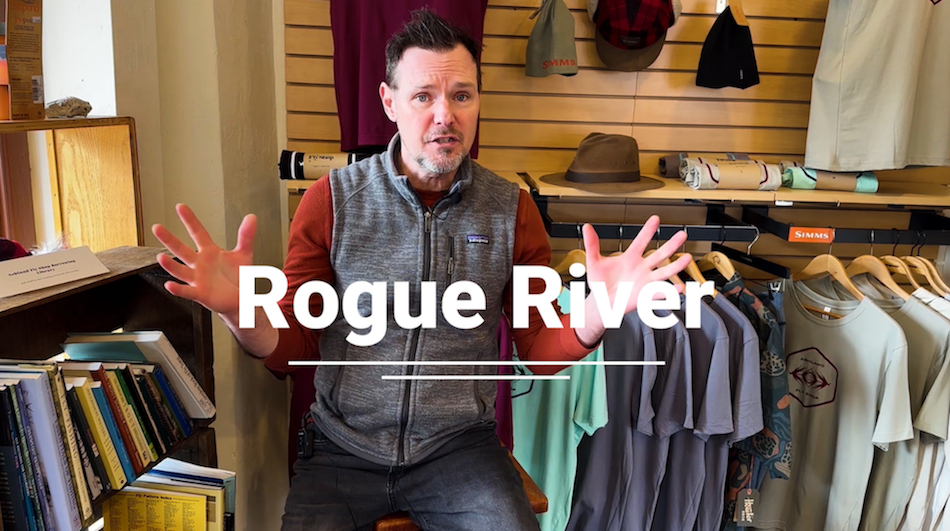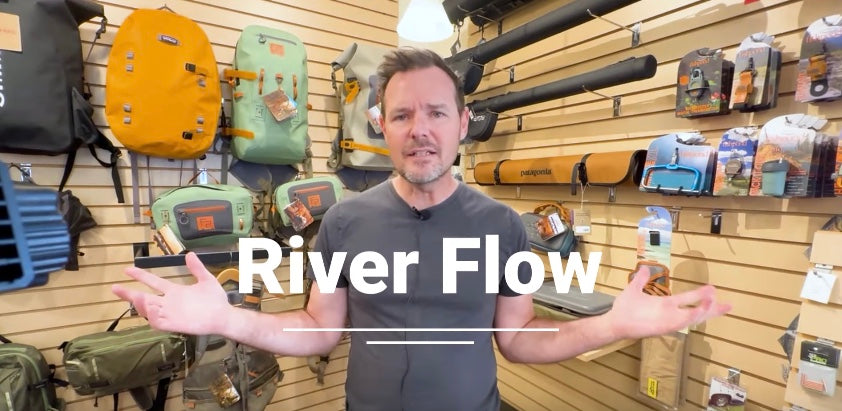MOW MANIFESTO
In the world of Spey Casting and Steelhead fishing, the process of selecting sink tips can be confusing and frankly overwhelming to new-comers. Hell, with this many new products flooding the shops each season it can be a challenge to keep up for the more experienced crowd, too. Within this article I am going to break down a system of sink tips that I think is truly the best option out there for versatility and efficiency, the MOW tips series from RIO Products. Apart from running through the standard 10’ tip kit, I’ll also touch on some new additions to the MOW family in 2019 and my initial thoughts on them as fishing and casting tools. First I’ll go over the original MOW series, because for me there is not a better set of tools in my guide bag than the MOW kits.

For a simple definition, a MOW tip is a 10’ tip made up of a floating section integrated into a length of level “T” material (T-8, T-11, etc.). First designed and made popular in the PNW by Spey and Steelhead gurus McCune, O’donnell, and Ward, the idea behind the integrated tip system is to allow an angler to fish a variety of sink tips while maintaining a fixed length of line, to help achieve a consistent cast regardless of the scenario. Not to mention the utility of shorter tips in real-world fishing situations-but there will be a bit more on that later.
Now, in general, a single integrated tip does not offer any more versatility than 10’ of T-14, or any other single tip for that matter. There-in lays the beauty of the MOW system. With a full kit, you get 6 different tips and a wallet to store them.
There are four different kits to choose from, each made with the different densities of “T” material. The options are Light (T-8), Medium (T-11), Heavy (T-14), and Extra Heavy (T-17). Each series is suited for different applications and rod weight, with Light tips ideal for any Spey rod from a 4-6wt, Medium works great from 6-8wt, the Heavy match up with stout 7-9wts, and the Extra Heavy are best matched with your 8-10wt big guns. As you can see there is a lot of crossover, and personally I don’t worry about matching the tip to the rod unless I’m using the Heavy and Extra Heavy tips.

In a standard MOW kit, there will be 6 tips labeled and stored in a RIO tip wallet. Included are the following, in their respective densities: 10’ floating tip, 2.5’ sink/7.5’ float, 5’ sink/5’ float, 7.5’ sink/2.5’ float, 10’ sink tip, and finally 12.5’ sink tip. Also available in the standard 10’ MOW configuration is the iMOW series, which simply replaces the floating section of the tip with an intermediate line. These are only available in Light-Heavy, with no T-17 option in the catalog. While these are another great option, for me there is not a big difference in applicability between the standard and the iMOW so I will just leave the two lumped together here. (Note: All of these tips are also available to purchase individually, allowing you to replace, duplicate, or mix and match.)
So you can see, a full kit leaves you with plenty of options to experiment with on the water while still providing the old tried and true 10’ of T-whatever to fall back on. That is going to allow you to try different approaches to the same water without taking away your confidence while you learn the new techniques. I’ll delve deeper into the issue of fishing these tips later on, but for now let’s take a quick look at the new members of the MOW family.

In 2019 RIO brought the benefits of integrated sink tips to the Long Rod community with the addition of the 15ft “Long MOW” tips (For me, in the context of Spey, a long rod is anything 13’6” and above; a 13’ rod still falls into the *standard* category in my world). Like the standard MOW kit, the Long MOW system comes with 6 different tips packed away nicely in a tip wallet. There are three series to choose from, Medium up to Extra Heavy, with each set containing the following tips: 15’ floating tip, 5’ sink/10’ float, 7.5’ sink/7.5’ float, 10’ sink/5’ float, 12.5’ sink/2.5’ float, and 15’ sink tip. In a nutshell the idea with the Long MOW is to retain all the benefits of integrated sink tips while being able to cast them consistently on longer rods. For example, your Spey rod of choice is a 6139-4 Sage X and you would like to fish a 5’ sink tip. Trying to cast your standard 5’ sink/5’ float MOW on this rod will be tricky, and blown anchors are inevitable for all but the most adaptable casters. Insert the 5’ sink/10’ float Long MOW, and now with added line stick and mass in your D-loop you can cast and fish that short sink tip with ease on your favorite fall Steelhead river. That idea carries through the entire Long MOW kit, with each tip allowing you to cover a different piece of water effectively while maintaining a proper cast.
Before moving on it is important to note that from a fishing standpoint, these new 15’ tips bring nothing new to the table unless you’ve been dying to cast 15’ of T-14. They just are not going to offer you any new options in real world situations when it comes to having an encounter with a fish. That said, for those of you who regularly use a rod longer than 13’ or just have problems blowing your anchor with 10’ tips, these could be a great tool to improve your casting.

The other big addition to the MOW line up last year was the 3D series. With these, we are back in the standardized 10’ total length of the sink tip, with the difference being that the 3D integrates 3 sink rates from slow in the rear, to faster up front towards the fly. The first and second sinking sections are 3’, with the third and fastest being 4’. There are 3 kits available ranging from Light to Heavy, with each one containing 3 different tips, they are: Intermediate/S3/S4, S3/S4/S5, and S5/S6/S7. The series or tip you choose depends on the general weight of your rod, with the Light series working well with 5-6wts and so on.Just remember that’s a suggestion and not a rule, choosing any tip is as much about the situation as it is the rod you use.

These integrated multi-density tips are no joke. I still cannot believe how beautifully they turn over big flies, and the advantage when fishing a slow swing is unrivaled. While you can fish these tips off a standard floating Skagit head in many ways and situations, the 3D MOW truly excels when paired with a multi-density shooting head like RIO’s Skagit Gamechanger. Being able to systematically transition from floating all the way down to a 7”/second sink rate creates a near-perfect, level, presentation of the fly while slowing your swing and cutting through the water column with ease. Perfect for less-than-ideal conditions of high pressure, low and clear water, bright light, or when the water gets cold. These tips are just bad-ass.
In short, there are an insane number of options to choose from within the MOW tip family and all of them catch fish. Now I’ll finally breakdown which Kit and tips I use the most, and why. My goal is to take all the information from above and give you an idea of how to keep it simple while maintaining the highest level of versatility and adaptability as possible.
The Breakdown
If a person wanted to fish for Steelhead all year with only one Skagit head, a Spey rod, and 3 tips, they would be able to find significant success with a selection from the standard Medium MOW kit. The 3 tips I would select in a heartbeat would be a 10’ floating tip, a 5’ sink/5’ float, and 10’ of T-11. With 3 tips to choose from we can keep it simple at the river, while still providing an effective fishing tool for nearly every situation you may encounter. I said early on that a single tip doesn’t lend many options, but if I had to narrow it down further to only one it would be an easy choice. The #1 most versatile and effective sink tip in my mind is the Medium (T-11) 5’ sink/5’ float (I’ll refer to is as a 5x5 from here on out). Out of every sink tip in my guide bag, this is the one that I have confidence in through the good times and the bad.

That being said, I like to be prepared for anything, and use tips from almost every series in the MOW line up depending on the situation. So now I’m going to talk about how and when I fish my go-to sink tips. For this part of the discussion I need to add two tips to my top 3, the Medium 3D S3/S4/S5 and Heavy 3D S5/S6/S7. I’ll start by addressing the least talked about of the MOW family, the floating tip.
For me, the 10’ floating MOW tip is a functional option for any dry line presentation. It may not give me the same pretty cast as a Scandi or Mid belly system but it keeps things simple in my pack and gets the job done. Whether I’m greaselining a Muddler or doing the down and across wet fly swing, I know I’m covered with this tip. There are also times when a broadside swing with a heavy fly, long leader and floating line can be a deadly swing tactic; in that situation the MOW tip and Skagit system performs far, far better than the other more delicately tapered floating lines. For those reasons I always keep a floating tip in my bag of tricks, no matter the time of year.

Like I said previously, the Medium MOW 5x5 is my all- around favorite tip. Not only can it be easily cast on a variety of set ups, it offers me the most versatility when it comes to effectively fishing in many situations. Casting is really fun, but my primary goal is and will remain to be catching Steelhead. With my 5x5 I can go from probing deep ledges and boulder gardens, to swinging fast and broadside in travel lanes, or starting the day covering a long even riffle, only to drift my fly through a soft seam in the afternoon, to getting down in to a bucket when the sun is out- all with nothing more than a spool of Maxima and some different flies. As a guide and angler, that’s absolutely huge for me. It’s also a great sink tip for getting the feel of how to fish a fly. A 5x5 is easy to steer and control, and the shorter length of sinking T-material makes visualizing the fly with accuracy a lot easier. As I do with any tip or presentation, I fish my fly through the run with a high rod tip. This gives my fly some wiggle room (literally), and provides a nice shock absorber when a fish grabs on. Just remember to let them eat it!

The next tip I use a lot throughout the year is 10’ of T-11, though I could easily sub in T-8 or T-14 and feel good about it. For rods in that 13’6” and up category this would relate to the 10’ sink/5’ float Long MOW. Now, 10’ tips are the bread and butter for a lot of people for good reason. They get your fly down in a hurry and keep it there with little effort from the angler. I personally fish 10’ tips when I want to put a fly in front of a fish and keep it there as long as possible. For me they excel when the fish are on the other side of fast water, or buried under a hard seam. The important thing here is to be very mindful of your casting angles and mends to the line. My goal is to keep the fly moving as slowly through the holding water as possible, so any belly in the shooting head should be avoided. When I’m fishing these long chunks of T material I worry about uneven sink rate through the tip and the chance of fish seeing my line before the fly. Since I have other ways to achieve a nice broadside presentation, I don’t take the chance with 10’ tips. I keep it simple and focus on a slow swing, with my fly dropping down into the fish instead of sweeping in front of it. I find this to be a great way to elicit strikes from stale fish, and have a much better hook to land ratio when using longer tips in this way.

The last two tips I’ll discuss are the 3D S3/S4/S5 Medium, and S5/S6/S7 Heavy. I like the Medium tip for having a multi-density option when fishing my 7wt, and the Heavy excels with 8 and 9wts for big water and big fish. With either of these tips I can fish a floating Skagit head or a multi-density version, depending on what feels right at the time. The 3D MOW helps to achieve a nice slow and even swing when the water cold, and cuts through fast surface currents or chop when the sun is right overhead. If you are a gear head and die hard sink tip angler, these tips are definitely something to check out this Winter season.
Like I said early on, sink tips can be confusing. There are endless variables in river conditions, and nearly as many different sink tips for the angler to choose from. Over the years I have found that MOW tips are the best system for me, and I think anyone who becomes familiar with their different applications will ultimately encounter more Steelhead as a result. As always, the best way to learn is from someone else, and booking a day of guided fishing is a great way to build confidence and learn the specifics of new techniques. So go get a MOW kit that suits your needs and start getting dialed, you’ll be happy you did.
Matt Katibah is an avid Steelhead angler, and a registered guide in New York, Alaska, Washington, and Oregon.
For info visit: www.anadromoustraditions.com
Photos by Chris Myron














